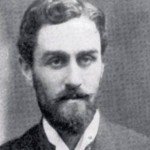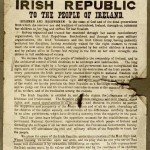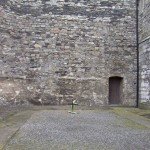
The Easter Rising was an armed insurrection by Irish Nationalists in Dublin, seeking to overthrow British rule and create an independent republic. It was launched in April 1916, a time when Britain was occupied with World War I. Controversially, the Irish rebels received some support, including weapons, from German agents. Ireland had seen many anti-British rebellions before 1916 – and most had proved unsuccessful. The Wolfe Tone rebellion, a 1798 attempt to cast off British rule and create an independent Irish state, collapsed after just a few months. The 1848 Young Ireland rebellion was also defeated, as was the 1867 Fenian uprising. Despite these failures, Irish Nationalists remained determined to free themselves from British influence. The April 1916 uprising proved no more successful than previous rebellions: it was crushed by British soldiers in just a few days, its leaders rounded up and either executed or imprisoned. Though it was quickly crushed, many historians consider the Easter Rising a pivotal moment in Irish nationalism and independence.
Home Rule
The context for the Easter Rising was a growing desire for Home Rule: the creation of a self-governing Irish nation within the United Kingdom. Home Rule had been a pressing issue in British politics for decades. After two failed attempts in the late 1800s, the British parliament passed the Home Rule Act in May 1914. This iteration of Home Rule was never implemented, however, due to the outbreak of World War I. Like others in Europe Irish Nationalists believed the war would be over quickly, so were willing to temporarily put aside their domestic political concerns. Instead, World War I became a long war of attrition with a staggering death toll. By 1916 the end of the war was not in sight and it seemed the implementation of Home Rule might be delayed indefinitely. The war also opened up political divisions within the Irish Nationalist movement. Some thought the Allied cause just and believed the Irish should fight in it; others believed Ireland had no place supporting Britain in a conflict which had little direct meaning for Ireland. These sentiments were expressed by Nationalists like James Connolly, leader of the Irish Citizen Army (ICA):
“If these men must die, would it not be better to die in their own country fighting for freedom for their class… than to go forth to strange countries and die slaughtering and slaughtered by their brothers… that profiteers might live?”

Radical Irish Nationalists were not content to wait for the end of World War I before seeking independence. As early as 1914 members of the Irish Republican Brotherhood (IRB) plotted to rebel and seize control of Ireland, while Britain and its powerful military were engaged in Europe. Setting Easter 1916 as the date for their rebellion, they worked with Nationalist supporters like Irish-born British diplomat Sir Roger Casement. Shortly after the outbreak of the war, Casement travelled to Germany to rally support for a Nationalist uprising in Ireland. The German government agreed to provide the Nationalists with arms and ammunition, in the hope that an Irish uprising would distract the British. Casement was intercepted and arrested by the British in early April 1916, days before the scheduled uprising. He was shipped to the Tower of London, put on trial for treason and executed in August that year. There was a further setback when leaders of the Irish Volunteers, the military wing of the IRB, could not agree on the timing of the rebellion. Several Irish Volunteers had fought alongside the British in Europe and had welcomed London’s transition to Home Rule; they felt that orchestrating an uprising when Britain was doing badly in a violent European war was inappropriate.

The leader of the Irish Volunteers, Patrick Pearse, ordered that the rebellion proceed as planned. Pearse was both a staunch Nationalist and a strong advocate for Irish identity, distinct Britain (in 1908 he opened his own school, St Enda’s to teach Irish language and culture). Pearse wanted an independent Irish republic rather than Home Rule. ICA commander James Connolly was a Marxist with similar Republican views. The rebels went ahead with their plan, launching an insurrection on April 24th. They seized the Dublin General Post Office just after noon, Pearse reading the proclamation of an independent Irish state from the steps of the building. Under the terms of the proclamation Pearse would serve as the first president of the new republic, while civil liberties would be guaranteed for all of its citizens. The proclamation was signed by the self-declared provisional government. Its members included Thomas Clarke (who assisted in planning the uprising), Sean Mac Diarmada, Thomas MacDonagh, Eamonn Ceannt and Joseph Plunkett, as well as Pearse and Connolly. The rebels hoisted the Irish tricolour above the post office, along with a second flag sporting the symbolic harp of Ireland.
After taking the post office the rebels seized other important locations in Dublin, including Jacob’s Factory, Bolands Mill, the Four Courts and the College of Surgeons. These locations were strategically important because they encircled the city centre. Smaller operations were also initiated outside the capital, mainly against Royal Irish Constabulary (RIC) posts. In Ashbourne, Irish Volunteers took the headquarters of the RIC and captured key locations in nearby villages. There were similar attempts in other distant places, such as Galway, where two members of the RIC were killed; and in Enniscorthy, near Wexford, where an attempt to seize the local RIC quarters failed. These rebel brigades were small in number and had no radio contact, so were unable to communicate effectively. This lack of coordination, coupled with the arrival of British reinforcements, contributed to the failure of the Easter Rising.
The British respond
“The disadvantage of martial law, aside from its powers being notoriously difficult to define, was that it ceded a propaganda success to the rebels at a time when the [British] government was striving to portray the insurrection as a local riot… Like so much else about the Rising, the alacrity with which the government set aside the rule of law reflected its wartime context.”
Fearghal McGarry, historian
On Tuesday April 25th martial law was declared in Dublin and thousands of British troops were deployed in the city. These soldiers took hold of strategic positions and access points. They established barricades around key locations, such as the post office, to prevent the rebels from escaping. The violence and incidental civilian deaths, coupled with the inconvenience of having the city shut down for several days, meant the rebels enjoyed little support from Dublin locals. By April 26th British army units were advancing through the streets of the capital. The gunboat Helga was moved up the River Liffey to fire on rebel positions; its weapons demolished the rebel stronghold at Liberty Hall before taking aim at the post office. This attack resulted in the destruction of several houses. The rebels’ fate was cemented by the arrival of over 10,000 troops from Britain, most landing in the afternoon and evening of April 27th. By that afternoon the GPO was ablaze and the Republicans were forced to flee to Hanlon’s Fish Shop. Taking refuge there, they weighed up their options. Aware they were defeated, the rebels contacted the British to negotiate terms of surrender. The British refused to offer terms, however, demanding their unconditional surrender. In no position to argue, negotiate or continue fighting, the rebels surrendered on April 29th.

The Easter Rising was an ambitious attempt to spark an Ireland-wide rebellion and bring an end to British rule. It had failed in less than a week. Those involved in the Rising were arrested, many locals hurling abuse at them as they led away. Over 400 people are believed to have been killed during the rising. The British Army claimed to lost 116 men along with 16 members of the RIC. Rebel and civilian deaths numbered 318 in total, of which 64 belonged to Republican groups like the ICA and IRB. The majority of those killed were members of the public, caught in small arms fire or the British artillery bombardment. More than 3,400 people were arrested in the aftermath of the Rising, though the majority were eventually released.
In total, 90 people were sentenced to death, including those named in Pearse’s proclamation as members of the Provisional Government. These rebels were executed swiftly, most dispatched in the first two weeks of May 1916. The execution of James Connolly evinced some public sympathy; Connolly’s ankle had been shattered by a British bullet and he was shot while tied to a chair. A handful of prominent Republicans managed to escape the executioner. Éamon de Valera was spared because his father was American and the British government was reluctant to offend its wartime trading partner. Michael Collins was interned at Frongoch Camp in Wales. Both men later played important roles in the struggle for an independent Ireland. What the rebels of 1916 could not achieve in life, they helped to achieve in death. Britain’s swift and brutal execution of the Republicans raised concerns about British policy in Ireland. It also generated some sympathy for the Republican cause. Many of the rebels interned by the British were released as early as December 1916.

1. The Easter Rising or Easter Rebellion was an attempt to seize control of Dublin by force of arms. Its aim was to form a Republican state of Ireland and incite an anti-British rebellion.
2. The Easter Rising was carried out by radical Republicans, led by Patrick Pearse, James Connolly and others. Most of its participants were dissatisfied with British plans for Home Rule in Ireland.
3. Armed with weapons provided by Germany, Britain’s wartime enemy, the Republican rebels began their action on April 24th, seizing control of the post office building in Dublin.
4. The Easter Rising gained control of central Dublin. It was put down within days due to lack of numbers, a lack of public support and the rapid deployment of British reinforcements.
5. Though unsuccessful, the Easter Rising was a watershed in Irish Republicanism. The rebels were arrested and swiftly executed by the British. Their brutal treatment invoked some sympathy for the Republican movement.

The Easter Rising Proclamation (April 1916)
W. B. Yeats poem: Easter, 1916 (1921)
© Alpha History 2017. Content on this page may not be republished or distributed without our express permission. For more information please refer to our Terms of Use.
This page was written by Rebekah Poole and Jennifer Llewellyn. To reference this page, use the following citation:
R. Poole and J. Llewellyn, “The 1916 Easter Rising, Alpha History, accessed [today’s date], https://alphahistory.com/northernireland/1916-easter-rising/
